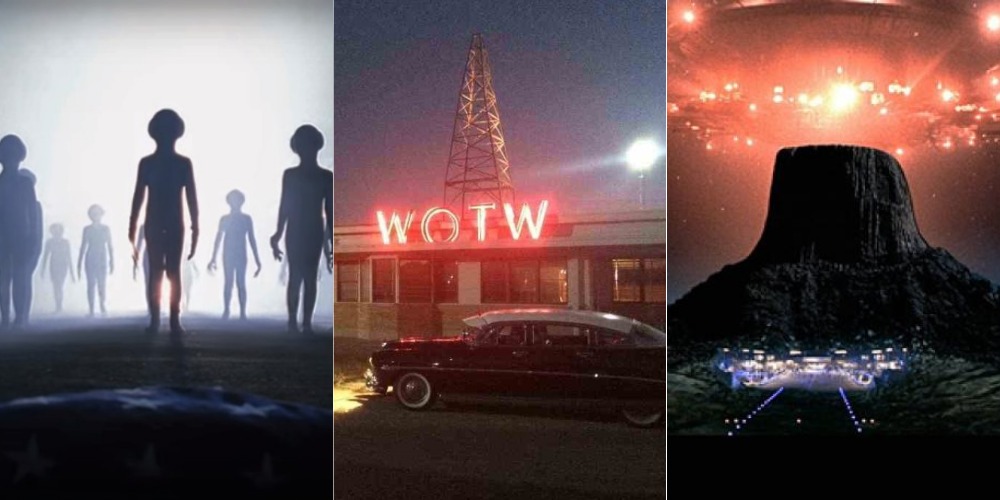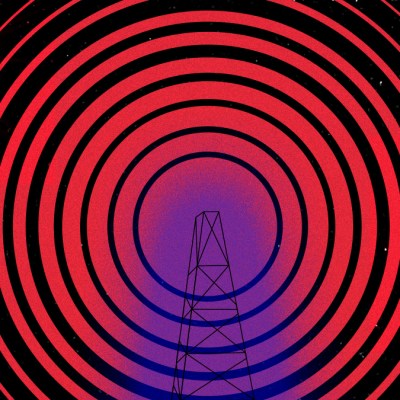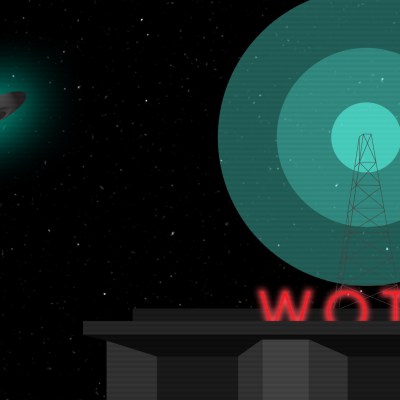UFOs: From Phenomena to Pop Culture
Can’t get enough of alien abductions, government cover-ups, and flying saucers? The fact is, sci-fi about UFOs is always preferable to storming Area 51.

Presented by: 
If the truth is out there, we don’t actually want to know what it is. For proof, let’s think about what happened in 2020 when footage of actual unidentified flying objects was released by the U.S. government to the general public. We all shrugged. The “unidentified” part of UFOs is what makes them fascinating in our imagination, but underwhelming in reality. The best UFOs aren’t conspiracy theories—they’re science fiction.
Whether they’re being tracked by Mulder and Scully on The X-Files, secretly hiding in out-of-the-way diners in The Twilight Zone, or, mysteriously buzzing around in the skies in the new indie sci-fi flick, The Vast of Night, aliens among us are always better in a sci-fi narrative. Whether you firmly believe a government conspiracy has been hiding alien bodies for years or if you think the decades-long obsession with alien abductions is ludicrous; we can all agree alien invasion stories, especially shadowy ones, are compelling. But why?
The short answer is this: UFOs have become horror comfort food. Since the 21st century began, saucer men have had their alien bodies assimilated by pop culture nostalgia. UFOs might have been innovative and daring sci-fi in the ‘40s, ‘50s, and ‘60s, but today, flying saucers are retro, a familiar form of escapism that now, almost exclusively, must be a period piece. 2020’s The Vast of Nighis a brand new indie UFO thriller, but tellingly, it’s set in the 1950s. The alternate universe “aliens” from the Upside Down in Stranger Things invaded during the ‘80s because we wouldn’t have accepted it otherwise. The last excellent X-Files episodes probably happened in 1998. Why did the oval-eyed aliens who were making crop circles and mutilating cattle basically go extinct after the ‘90s?
It’s a case of video killing the radio star. But with flying saucers, the cameraphone killed alien abduction and conspiracy theories. Jack Womack, the author of …Flying Saucers Are Real, a nonfiction book all about UFO history, first-person accounts, and hoaxes, has pointed out that:
“Going by both research and empirical observation, the number of UFO reports dropped off significantly in the early 21st century.”
Once we got iPhones, eyewitness stories about having seen UFOs or being abducted by aliens simply weren’t as compelling. And so, this brand of invading aliens have perpetually been trapped in the 20th century where we like them. Sure, The X-Files returned in 2016 and 2018 for the long awaited seasons 10 and 11, but the most interesting storylines were arguably not about aliens, but instead the search for Scully and Mulder’s super-powered “son.” Jordan Peele’s new Twilight Zone mostly avoided space aliens, too, and other than the episode “A Traveler,” the mysterious phenomena in the recent Twilight Zone episodes were mostly reflections of human foibles, rather than an outside invading force.
Then again, old-school Twilight Zone did this, too. Paranoia about UFOs is always scarier than the aliens themselves. The most famous examples of this are The Twilight Zone’s“The Monsters are Due on Maple Street,”“Will the Real Martian Please Stand Up?” and the 2019 reboot’s “The Traveler,” which is kind of a loose remake of this premise. In all three of these stories, the revelation of actual aliens is saved for the very end, and in the case of “Will the Real Martian Please Stand Up?” the twist isn’t just that there was really an alien there, but that there were actually two.
The full revelation of these aliens, just like the famous finale of Close Encounters of the Third Kind, has to happen in the denouement, otherwise it’s no fun. If you reveal your alien early in your TV show or movie, there’s a good chance the whole thing is either set in the future (Alien) the aliens are friendly (E.T.) or both (Star Trek, et al.) Invading aliens on earth, or possible UFOs (like in The Vast of Night) are at their best when they’re hypothetical and undefined. Even M. Night Shyamalan got this right in Signs; he kept the aliens in the shadows, or locked in closets. Nobody wants to see a sequel to Close Encounters of the Third Kind where Richard Dreyfuss is chilling on the spaceship. There’s no need for War of the Worlds Part 2.
UFO-style aliens are the ending of a story we all imagine we’re living in. No amount of declassified documents will make anyone happy, because we actually don’t want the story to end. Buried in the terror of an impending alien invasion, or a slow takeover replete with abductions and cover-ups, is actually a weird element of hope. UFO narratives like The X-Files, The Twilight Zone, Close Encounters, or The Vast of Night are about the creepy calm before the storm. The invasion hasn’t happened yet.
Comparing notes about crop circles, abductions, and grainy photos about what may or may not be in Area 51 isn’t about the search for answers, it’s about exploring our anxieties in those questions. This is how people connect. But if the unidentified flying objects become identified, and our anxieties are defined too specifically, everybody becomes aliens to themselves. We want to believe…but we don’t want to know for sure.
The Vast of Night is now streaming on Prime Video.


